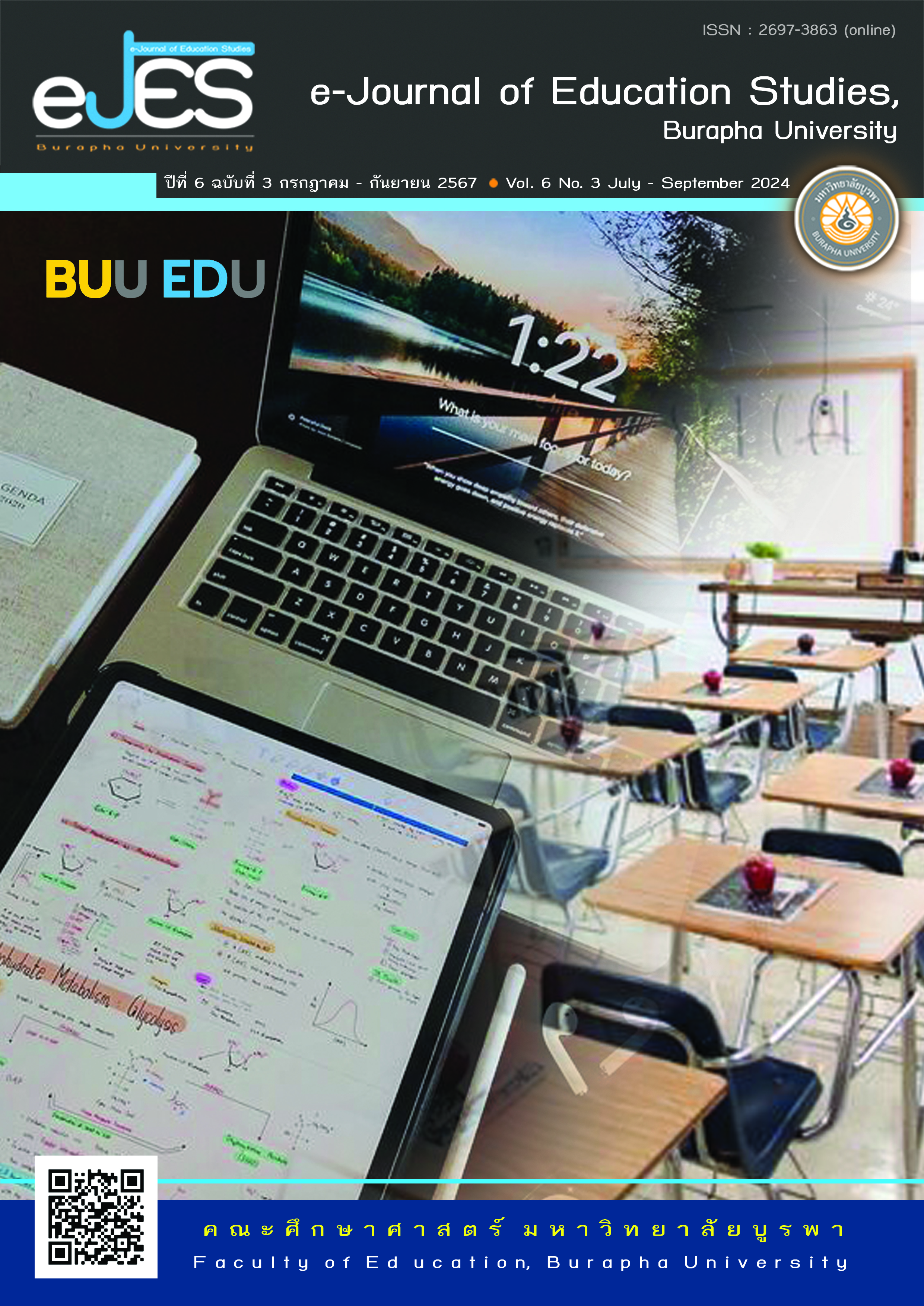โปรแกรมทฤษฎีการเรียนรู้ทางสังคมร่วมกับการพับกระดาษโอริกามิเพื่อเสริมสร้างการควบคุมยับยั้งของนักเรียนมัธยมศึกษาตอนปลาย
Main Article Content
บทคัดย่อ
การวิจัยนี้เป็นการวิจัยกึ่งทดลองมีวัตถุประสงค์ 1) เพื่อเปรียบเทียบการควบคุมยับยั้งของนักเรียนมัธยมศึกษาตอนปลายที่เข้าร่วมโปรแกรมการเรียนรู้ทางสังคมร่วมกับการพับกระดาษโอริกามิเพื่อเสริมสร้างการควบคุมยับยั้งของนักเรียนมัธยมศึกษาตอนปลาย ระหว่างก่อนทดลอง หลังทดลอง และระยะติดตามผล 2) เพื่อเปรียบเทียบการควบคุมยับยั้งของนักเรียนมัธยมศึกษาตอนปลายระหว่างกลุ่มทดลองกับกลุ่มควบคุม โดยมีกลุ่มตัวอย่าง คือ นักเรียนมัธยมศึกษาตอนปลายโรงเรียนเอกชนแห่งหนึ่ง อายุ 12-17 ปี จำนวน 36 คน ไม่มีความบกพร่องการมองเห็นและการได้ยิน สมัครใจเข้าร่วมและได้รับการยินยอมจากผู้ปกครองรับการประเมินด้วยแบบทดสอบโกโนโกทาสค์จากนั้นเรียงคะแนนจากมากสุดไปน้อยสุด จับคู่คะแนนกลุ่มละ 18 คน สุ่มอย่างง่ายโดยหยิบสลากเลือกกลุ่มควบคุมและกลุ่มทดลอง กลุ่มทดลองจะได้รับโปรแกรมฯ ซึ่งผู้วิจัยพัฒนาขึ้น จำนวน 6 ครั้ง 50 นาทีต่อครั้ง ดำเนินการ 3 ครั้งต่อสัปดาห์ รวมทั้งสิ้น 2 สัปดาห์ ประเมินผลเป็น 3 ระยะ ก่อนการทดลอง หลังการทดลอง และระยะติดตาม 3 สัปดาห์ วิเคราะห์ความแปรปรวนแบบวัดซ้ำประเภทหนึ่งตัวแปรระหว่างกลุ่มและหนึ่งตัวแปรภายในกลุ่มและเปรียบเทียบเป็นรายคู่ด้วยวิธีบอนเฟอร์โรนี พบว่ากลุ่มทดลองมีคะแนนการควบคุมยับยั้งหลังทดลองสูงกว่าก่อนทดลอง และสูงกว่ากลุ่มควบคุมในระยะหลังทดลองอย่างมีนัยสำคัญทางสถิติที่ระดับ .05 (p<0.05) สรุปได้ว่าโปรแกรมฯ อาจช่วยเสริมสร้างการควบคุมยับยั้งได้
Article Details
เอกสารอ้างอิง
B.J. Winer, D. R. B., Kenneth M. Michels. (1991). Statistical principles in experimental design (3ed.). New York: McGraw-Hill.
Bandura, A. (1969). Social-learning theory of identificatory processes. Handbook of socialization theory and research, 213, 262.
Bandura, A., & Barab, P. G. (1971). Conditions governing nonreinforced imitation. Developmental Psychology, 5(2), 244-255. https://doi.org/10.1037/h0031499
Bezdjian, S., Baker, L. A., Lozano, D. I., & Raine, A. (2009). Assessing inattention and impulsivity in children during the Go/NoGo task. Br J Dev Psychol, 27(2), 365-383. https://doi.org/10.1348/026151008x314919
Cragg, L., & Nation, K. (2008). Go or no‐go? Developmental improvements in the efficiency of response inhibition in mid‐childhood. Developmental Science, 11(6), 819-827.
Department of Mental Health. (2021, Fenuary 3). Why are children having more Pseudo-ADHD?. https://dmh.go.th/news-dmh/view.asp?id=30174 (in Thai)
Diamond, A. (2002). Normal development of prefrontal cortex from birth to young adulthood: Cognitive functions, anatomy, and biochemistry. Principles of frontal lobe function, 466-503.
Diamond, A. (2013). Executive functions. Annu Rev Psychol, 64, 135-168. https://doi.org/10.1146/annurev-psych-113011-143750
Duncan, J., Burgess, P., & Emslie, H. (1995). Fluid intelligence after frontal lobe lesions. Neuropsychologia, 33(3), 261-268.
Eriksen, B. A., & Eriksen, C. W. (1974). Effects of noise letters upon the identification of a target letter in a nonsearch task. Perception & psychophysics, 16(1), 143-149.
Hommel, B. (2011). The Simon effect as tool and heuristic. Acta psychologica, 136(2), 189-202.
Howell, D. C. (2012). Statistical methods for psychology. Cengage Learning.
Imaroonrak, S., Phunwutikorn, P., Phattharayuttawat, S., Ngamthipwatthana, T., Sumalrot, T., & Auampradit, N. (2018). The Effects of Origami Training on Creativity and Visual-motor Integration in Preschool Children. Journal of the Medical Association of Thailand, 101(1), S85-S89.
Jones, L. B., Rothbart, M. K., & Posner, M. I. (2003). Development of executive attention in preschool children. Developmental Science, 6(5), 498-504.
Lu, C.-H., & Proctor, R. W. (1995). The influence of irrelevant location information on performance: A review of the Simon and spatial Stroop effects. Psychonomic bulletin & review, 2, 174-207.
MacLeod, C. M. (1991). Half a century of research on the Stroop effect: an integrative review. Psychological bulletin, 109(2), 163-203.
Miyake, A., Friedman, N. P., Emerson, M. J., Witzki, A. H., Howerter, A., & Wager, T. D. (2000). The unity and diversity of executive functions and their contributions to complex “frontal lobe” tasks: A latent variable analysis. Cognitive psychology, 41(1), 49-100.
Mueller, S. T. (2011). The PEBL Go/No-Go test. Computer software. Retrieved from http://pebl.sf.net/battery.html
Mullane, J. C., Corkum, P. V., Klein, R. M., & McLaughlin, E. (2009). Interference control in children with and without ADHD: A systematic review of Flanker and Simon task performance. Child neuropsychology, 15(4), 321-342.
National Statistical Office Thailand. (2022, May 17). Summary the survey results on the use of information and communication technology in households 2021. (n.p.) https://www.nso.go.th/nsoweb/nso/survey_detail/jJ?set_lang=th (in Thai)
Posner, M. I., DiGirolamo, G. J. (1998). Executive attention: Conflict, target detection, and cognitive control. In: R. Parasuraman (Ed.),The attentive brain(pp. 401-423). Cambridge-Massachusetts, London-England: A Bradford Book, The MIT Press.
Riviere, J., & Lecuyer, R. (2003). The C-not-B error: a comparative study. Cognitive Development, 18(3), 285-297.
Theeuwes, J. (1991). Exogenous and endogenous control of attention: The effect of visual onsets and offsets. Perception & psychophysics, 49(1), 83-90.
Thorndike, E. L. (1898). Animal intelligence: An experimental study of the associative processes in animals. The Psychological Review: Monograph Supplements, 2(4), i-109. https://doi.org/10.1037/h0092987
Verbruggen, F., & Logan, G. D. (2008). Automatic and controlled response inhibition: associative learning in the go/no-go and stop-signal paradigms. Journal of Experimental Psychology: General, 137(4), 649.
Waltz, J. A., Knowlton, B. J., Holyoak, K. J., Boone, K. B., Mishkin, F. S., de Menezes Santos, M., Thomas, C. R., & Miller, B. L. (1999). A system for relational reasoning in human prefrontal cortex. Psychological science, 10(2), 119-125.



